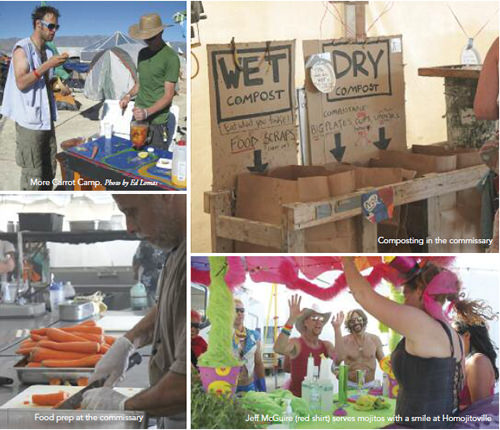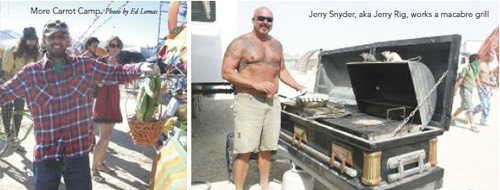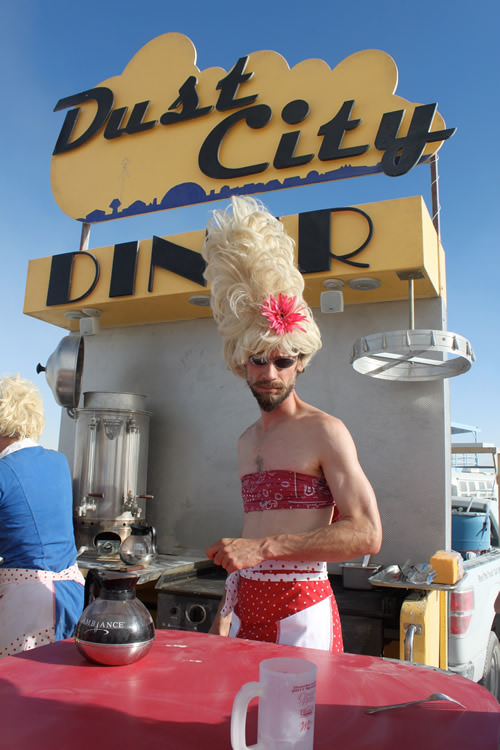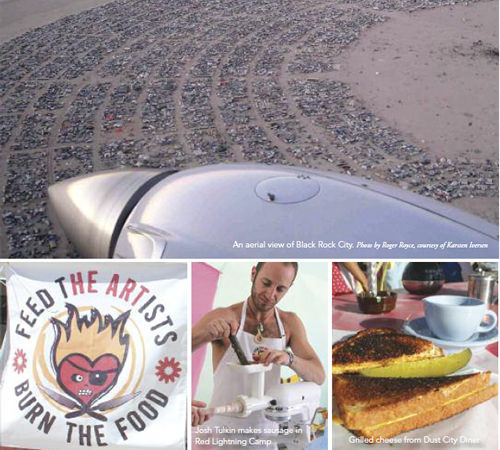POTLUCK ON THE PLAYA
Uncovering Burning Man’s food and drink culture.
WRITTEN BY AMANDA BURDEN
PHOTOS BY JACI GOODMAN (AND ED LOMAS FOR MORE CARROT CAMP AND
COURTESY OF KARSTEN DAMGAARD-IVERSEN FOR THE AERIAL PHOTO)
If you’ve made the trek to Burning Man over the course of its 22-year history in the Black Rock Desert near Gerlach, Nev., you have experienced the weeklong spectacle and heartfelt celebration of art, life, and community. If you’ve participated you know about the entertaining and kooky theme camps and events, including roller-skating, body painting, yoga, and beer-in-hand soccer. And you’ve probably embarked upon a tour of the interactive, thought-provoking art aboard an art car or bicycle.
Some come for wild fire and light shows, underground film festivals, interpersonal workshops, hoop lessons, jewelry making, short-term weddings, and to dance in the dirt to internationally known DJs. Others enjoy guided nature walks and like to quietly commune with their campmates and fellow Burners. Yet, not many know about Burning Man’s world of food and drink. So here edible Reno-Tahoe offers a glimpse into the festival’s culinary scene.
For guaranteed sustenance, veteran Burners know to bring enough provisions for themselves and/or their campmates to last the duration of their stay, whether it’s one night or all week. The most important element to lug along is lots of water to hydrate from the effects of the scorching sun, wind, and harsh conditions. In terms of food, participants may pack no-fuss precooked meals or salty and sweet snacks. But when strolling across the playa one might see campmates dining on gourmet fare, including barbecued elk burgers, paella for 60, an extravagant seven-course Cajun meal, and freshly caught tuna sashimi from The Tuna Guys (fishermen from Coos Bay, Ore., who started bringing — and gifting — their fresh catch to the playa crowd in 1998).
Participants are discouraged from buying or selling anything, as Burning Man operates as a gift economy. However, ice, coffee, espresso drinks, and a darn good chai tea latte are available for purchase. Beyond that, Burners are on their own.
Yet, participants — who travel a few hours or a few days and come from Reno-Tahoe, Massachusetts, Macedonia, and all over the world for the event — can quench their thirst and fill their bellies with many edible and drinkable surprises while roaming the playa, whether out in the morning or the wee hours of the night. The best way to score food is to look for lines. Just remember: Bring your own cup, plate, and utensils.
Food Focus
If you were one of the fortunate 51,000-some people to win a ticket to this year’s event be sure to look up these returning food- and drink-focused theme camps: Pancake Playhouse, Pickle Joint, Lamplighters (which offered a bloody Mary brunch, sangria soiree, and more last year), Vietnamese Iced Coffee camp, and White Dragon Noodle Bar. Home Brew 4A Home Brew camp will bring back its eating and imbibing functions (last year, Burners delighted in French press coffee, jelly bean and gummy, eggnog and fruitcake, chocolate, vodka, pickle, honey, and asparagus tastings at the camp). Employees, owners, and friends of The Melting Pot in Reno again will host MidNite Popcorn Palace, featuring the popular salty snack. The camp, which began dispensing popcorn in 1999 and is usually located in the 3 o’clock plaza, is open from midnight until about 3 a.m. every night and occasionally has “day pops.” Participants munch on organic, non-genetically modified popcorn with a choice of about 10 seasonings. Over the course of the week, Melting Pot owner Eric Baron says he serves up 350 pounds of popcorn.
Also in Melting Pot’s camp are Mairin Tausch and her project. The Melting Pot merchandise manager offers Thanksgiving dinner on the Thursday of the event, mainly for campmates. At last year’s eighth-annual feast about 120 people dined on five stuffed turkeys slowly roasted on a custom grill. Typical Thanksgiving fixings — such as mashed potatoes, green bean casserole, and gravy — also were served.
“Burning Man makes me feel grateful,” Tausch says. “So I thought Thursday should be all about Thanksgiving.”


Refreshing Treats
Those craving fresh, local fruit and vegetables should search for More Carrot Camp, host of Black Rock City Farmers’ Market for three years. It operates 8 to 10 a.m. Tuesday through Friday from mobile and stationary camps. Reno Farmers’ Market Manager Shirley Sponsler has helped the camp source local produce, which is then gifted to Burners. Last year campmates — from Australia, the United Kingdom; Germany; Washington, D.C.; Boston; San Francisco; Los Angeles; and other areas — bought $1,900 worth of fruits and vegetables from local growers. More Carrot campmates also offer nuts, chocolate-covered fruits, pickles, and fresh-made juices. Sometimes passersby gift homemade granola, pots of honey from their hives, homemade jars of salsa or jelly, and fruit and vegetables from their gardens.
“Our mission is to bring fresh fruit and vegetables to our dusty brethren on the playa,” says More Carrot Camp member Jessie Newburn of Columbia, Maryland. “We source almost everything in Reno and are very grateful for the friendliness and kindness of the farmers and produce companies with which we’ve worked.”
Snow cones were a big hit last year. These refreshing treats were, thankfully, offered at several camps. Frozen sweets at the solar-powered popsicle stand were popular as well. Last year Burners also found s’mores at S’mores Amour Camp; quesadillas at Nose Fish camp; calamari rings at Dr. Snippet’s Circumcision Wagon and Calamari Hut; turkey sandwiches and a potluck barbecue at Hello Gigsville camp; gumbo, crawfish boils, mint juleps, and more at Black Rock French Quarter camp; milk and cookies at Camp of Misfit Toys; tacos, breakfast burritos, iced tea, and lemonade at Kosmik Dust camp; a pancake ball at Burning Stump camp; PB&J sandwiches at Rancho Amarillo Collective; pancakes, coffee, and bacon at Dub Scouts Troop 808; freshly made doughnuts, coffee, tea, and hot chocolate at Kamp Kammaniwannalaya; lox, bagels, and coffee at Couch Burner Camp; Jewish challah bread and French toast at Mystopia camp; a Vegan Pita Party at Black Planet camp; Brian Brunch for everyone named Brian with Belgian waffles, veg playa balls, and coffee at Mission Country Club camp; and Shabbatluck Dinner with non-meat dishes to share for Shabbat. Every unexpected bite is experienced in a gratifying and communal way — and is coated with fine white dust.

Spirits, wine, beer, and nonalcoholic beverages are easy to come by as well. Last year’s choices featured tequila shots at The Leopard Lounge and Day Spa; bacon bloody Marys at Buddha Camp; Chambord mimosas at Camp D.O.A.; margaritas at Brain Freeze camp; mojitos at DeMentha camp; sun tea at Yurt Café; chai tea from Karma Chickens camp; Irish cream at Camp D.O.A.; home brew tasting at Black Rock Brewery camp; absinthe tasting at Rites of Spring Camp; cider at the Couch Burner Camp; root beer floats at the Mudskippers Urban Decay Café Camp; wine tasting at Barbie Death Camp; lemonade at Planet Earth camp; green superfoods and coconut water cocktails at French Maid Brigade camp; and smoothies at Free Fall camp.
People can even participate in food and drink classes, which last year included a fermentation workshop, tasting, and potluck; mixology masters 101 and bartending 101 classes; brewing workshops; a class on creating vegan protein bars in a solar oven; vegan meal talks; and an urban farmer class to discuss sustainability in your yard.
Mass Feeding
Most participants come into contact with individual camps’ generous sharing of grog and grist. But peek into Burning Man’s underbelly and discover several camps working on large-scale meal operations. The largest is the commissary, a commercial kitchen that feeds thousands of volunteers responsible for building, operating, and tearing down the city. They work the gate, perimeter, department of mutant vehicles, airport, media center, emergency services, ranger and greeter duties, center camp café, technology, department of public works, and more.
“Up to about a month prior to the event, the commissary feeds 1,000 people per meal (breakfast, lunch, and dinner),” says Hayseed, a 32-year-old chef from North Dakota who has managed “employee” food services for the last two years. “That number drops off during the event because people often meet up with campmates. The commissary stays open about a week after the burn, too.”
Shelley Gatchell, vice president of artist and tour catering at Spectrum Catering in Houston, was hired to manage the commissary for three years. A small group of Spectrum employees and an army of volunteers accomplish the feat of serving about 450 for breakfast, 780 for lunch, and 816 for dinner during the event, Gatchell says. In terms of meal planning, Gatchell tries to accommodate all diets, including vegans and those who are sensitive to gluten. She says she tries to source locally. Then Bonanza Produce in Reno and Sysco meet the rest of their needs.
Chefs also are pushing the limits of what it means to cook on the playa in the Feed the Artists camp, another large-scale food enterprise. Volunteers help prepare and serve food mostly to artists working on the giant art installations, including the temple. Last year, Red Lightning, a camp consisting of a series of connected tents and yurts run by Hare Krishnas, worked closely with Feed the Artists. Last year, Nitai das (Elisha Drury), founder of Krishna Kitchen (who passed away on Jan. 31 of this year), said that he was serving three meals a day for 250 people and occasionally preparing 600-people feasts, including chocolate pancakes, vegan specialties, 40 gallons of soup, and other lavish initiatives.
“A lot of effort goes into having a food camp,” says Andie Grace, Burning Man communications manager. “There’s the commissary that feeds workers, restaurant-style camps, and group camp dinners. Preparing a seven-course meal in the godforsaken desert is hard work.”
Burning Man is an extraordinary experiment in temporary community. It is awe inspiring and one of the world’s most unusual and progressive cultural festivals. But if you go, don’t be a tourist. Participate, volunteer, bring something to share, make merry, and don’t forget to sample the thoughtfully prepared food and drink.
Burning Man is Aug. 27 – Sept. 3 this year. For details, visit www.Burningman.com. For details on the farmers’ market camp, visit www.Facebook.com/BRCfarmersMarket.
Amanda Burden is publisher and editor of edible Reno-Tahoe and she will be making her seventh trek out to Burning Man this year.
“¿Te gustaría algo diferente?”
The Reno-Tahoe region possesses a variety of underexplored Mexican sweets. Particularly during the holidays, comforting novelties abound within our panaderías. Picture upbeat bakeries bursting with vibrant, slightly sweet pan dulce, meaning sweet bread or pastry. Here are a few noteworthy stops to inspire you. Al gusto!
King’s Ring
El Torito has served the Carson City area since 1997. This establishment, which is a butcher, grocery, and bakery, offers delectable Mexico City-style pastries. Hector Cruz and his family maintain high-quality recipes that lie in longstanding customs. Upon entering the store, prepare to be beckoned by a decadent array of treats. Buñuelos, crispy flour tortillas rolled in sugar and cinnamon, fly off shelves by the dozens. Come Jan. 6, a line spills out the door – as they do each year – for the treat Rosca de Reyes (King’s Ring), which celebrates the Catholic Ascension. El Torito prepares this ring-shaped dessert with homemade fruit preserves and specially milled flour only during this time of year.
El Torito Super Mercado
308 E. Winnie Lane, Carson City
775-884-4294
Open 8 a.m. – 9 p.m. Mon. – Sun.
Luscious Delicacies
Maria and Merced Perez acquired Panadería Las Palomas in 2008 after 20 years of baking and cake decorating in Reno’s casinos. Their love of the trade sparked the desire to operate a central venue serving traditional Mexican goodies, but also focusing on novel items such as red velvet cake and custom wedding cakes. The quality is evident in Las Palomas’ dense and luscious delicacies, made with recipes synthesizing experience and innovation. Maria is attentive to her clients’ sensitivities to unfamiliar treats. So she makes it a point to offer generous samples to customers.
Panadería Las Palomas
814 S. Wells Ave., Reno
775-323-1881
Open 6:30 a.m. – 8 p.m. Mon. – Sun.
Authentic Cakes
Opened in 2007, La Promesa serves decadent cakes, pastries, and sumptuous Mexican fare in the South Lake Tahoe area. Owner Jose Granillo says most of his customers come upon the restaurant through word of mouth. He remarks that his loyal clientele has kept the place thriving, despite the economic downturn.
“Try it for yourself,” he says. “The freshness and authenticity will bring you back, without a doubt.”
Overall, La Promesa’s cakes literally take the cake. Try one of their best sellers — Torta de Mil Hojas (several crêpe-like layers of cake with dulce de leche, or caramel, in between) and Tres Leches (fluffy sponge cake soaked in various types of milk) — after a riveting day on the slopes.
La Promesa Bakery
3447 Lake Tahoe Blvd., South Lake Tahoe
530-541-2019
Open 10 a.m. – 8 p.m. Mon. – Sat., 10 a.m. – 5 p.m. Sun.
These panaderías distinguish their creations with heartfelt care originating in age-old traditions and provincial styles. We are fortunate to be surrounded by such a variety of specialty Latino indulgences, all of which are meant to be enjoyed to the fullest.
Rachael Scala is a freelance writer who advocates wholesome, local, and responsibly cultivated foods. Her travel, study, and volunteer experiences have exposed her to many facets of modern food systems. If she’s not out enjoying the Sierra Nevada, you may find her experimenting with her latest batch of kombucha tea.


